The Goals of the Presentation
This presentation is aimed at achieving the following goals:
- To analyze the ideas of Stephen Covey, in particular the habit that he calls First Seek to Understand, Then to be Understood;
- To identity and discuss the major components of this habit;
- To show how these principles can be applied in real-life situations.
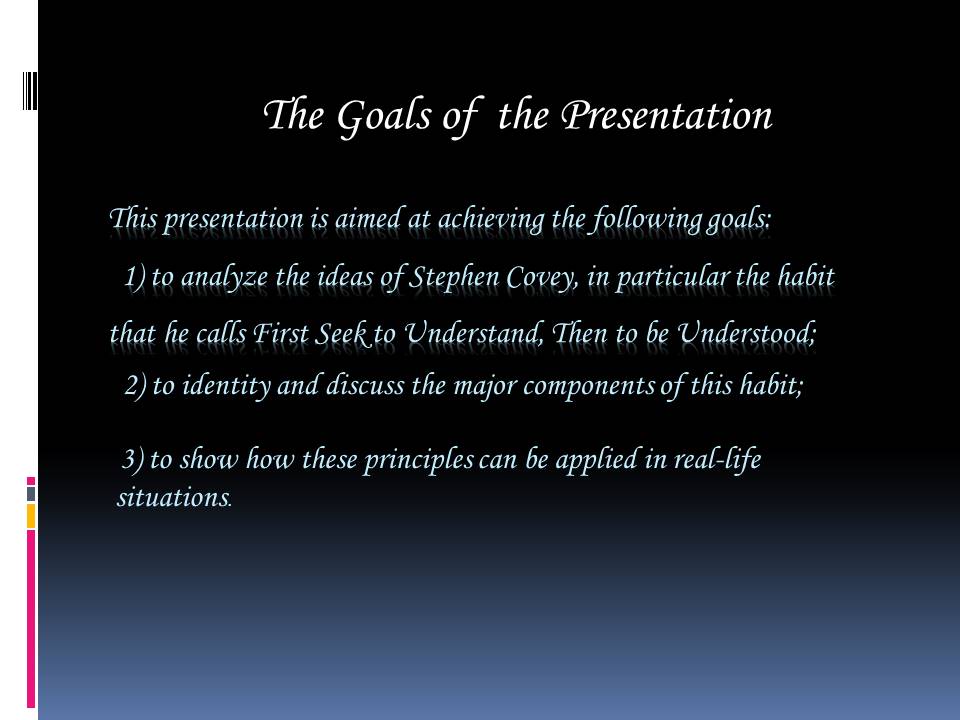
First Seek to Understand, Then to be Understood: The Main Components of the Habit
The main principles of this habit are as follows:
- Do not prescribe before diagnosing;
- Listen Empathetically;
- Avoid autobiographical responses;
- Use pathos, ethos and logos when communicating.
These are the main principles that David Covey identifies in his book The Seven Habits of Highly Effective People. The following slides will explain the core principles of this habit and illustrate how they can be applied in real-life situations.

Do not prescribe before diagnosing: What this principle is about and why it is important
- 1First, think about the needs, values and attitudes of a person;
- Gather as much information as possible about a certain situation;
- Do not suppose that another person thinks just as you do.
The main idea that Steven Covey stresses is that people often tend to jump into conclusions when they assess the behavior of individuals or a specific situation. Moreover, sometimes they think that other people have a similar view on ethical or professional problems. The author warns people against making such mistakes.
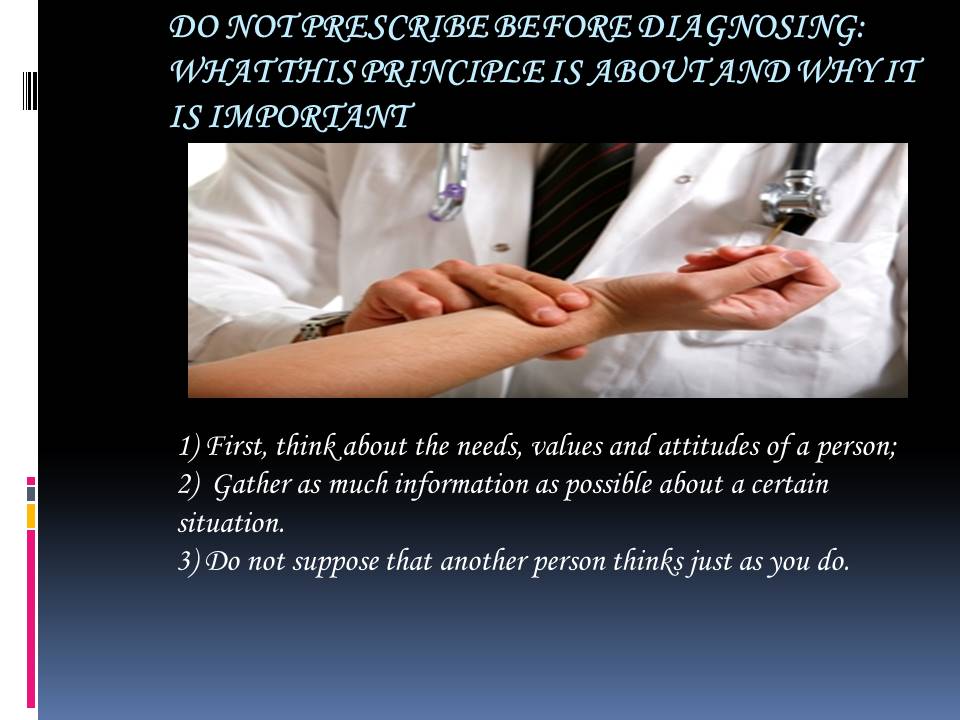
The Importance of Proper Diagnosis
This safeguard can help you different ways:
- It will allow you to avoid many disagreements and conflicts both at home and in the workplace.
- This principle will help you better find a compromise or a win-win solution.
- You will maintain better interpersonal relations with your friends, relatives, or colleagues.
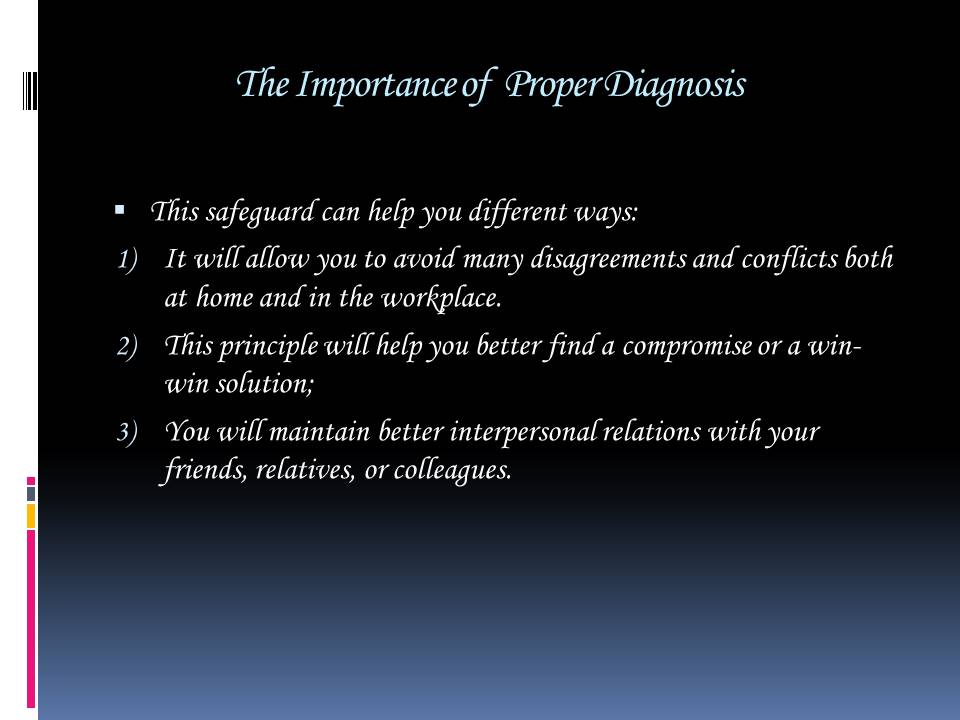
Diagnose Before Your Prescribe: An Exercise for the Audience
- Try to remember a conflict or a disagreement that you have recently had.
- Gather as much information as possible about this situation;
- Write down your views on the situation. Focus on your attitudes, beliefs, and basic assumptions.
- Think about the views of a person with whom you had a disagreement. If it is possible, ask this individual about his or her opinion.
- Compare your assumptions and the assumptions of your interlocutor or even an opponent.
You will see that to some extent both of your were right and that this conflict or disagreement could have been avoided.
This is a take-home exercise for the audience. It is aimed at showing that very often people have different views on the situations, however they often assume that other individuals think just in the way that they do. This is one of the main reasons for many conflicts and disagreements.
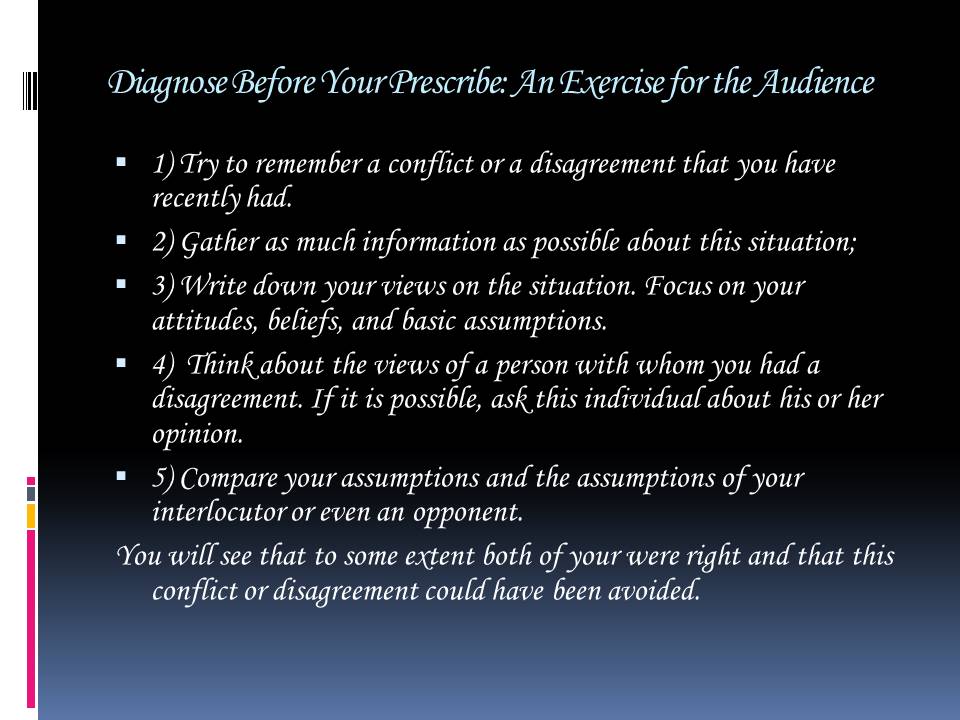
Empathic Listening: Understanding Empathy
Empathy can be defined as willingness and ability to understand the feelings and emotions of another person. This diagram illustrates the components of empathy.
Empathy involves effective listening, attentiveness, and caring for another individual. Without it, one can hardly become an effective communicator. The components that have been identified are important because they show what kind of attitudes and skills a person should have to listen effectively.

Listening Empathically The Main Rules
- Listen with an intent to understand, not with an intent to reply.
- Pay attention not only to the words of a speaker, but to body language as well.
- Do not project your own personality on the words of another person.
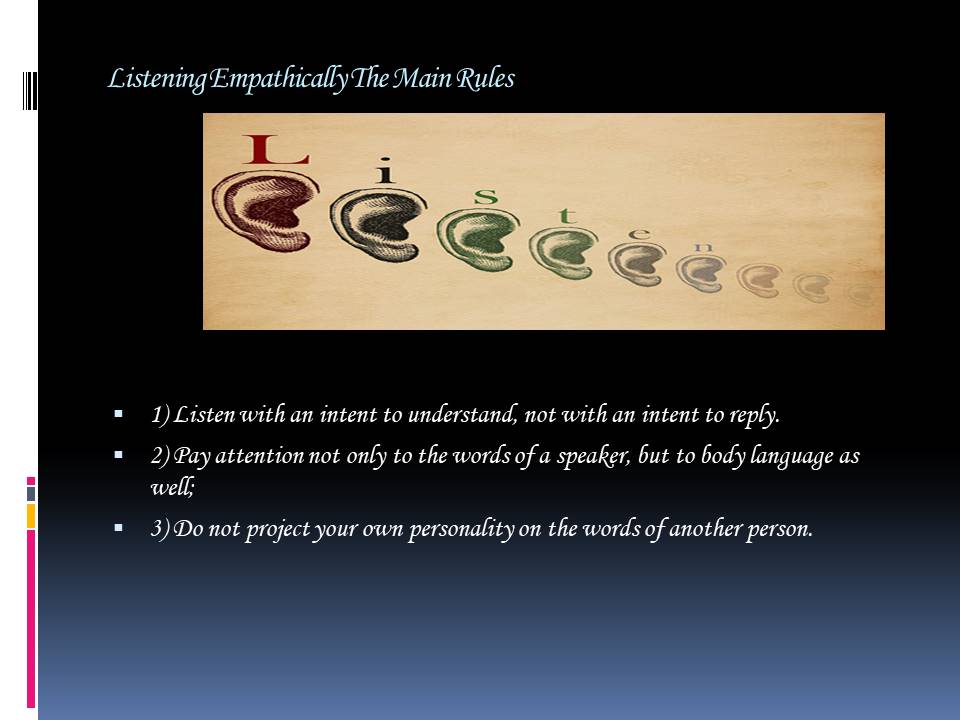
The Development of Empathic Listening
The following diagram different levels of listening and responding:
- Mimicking the content which is repeating the words of a person
- Rephrasing the content in one’s own words
- Reflecting upon the feeling of another person
- Rephrasing the content and reflecting about the feelings of a person.
These diagram illustrate different levels of empathic listening and reacting to the statements of other individuals. A person, who wants to become a good communicator, should be able to rephrase content and reflect about the feelings of an another individual. This approach will yield the best results.
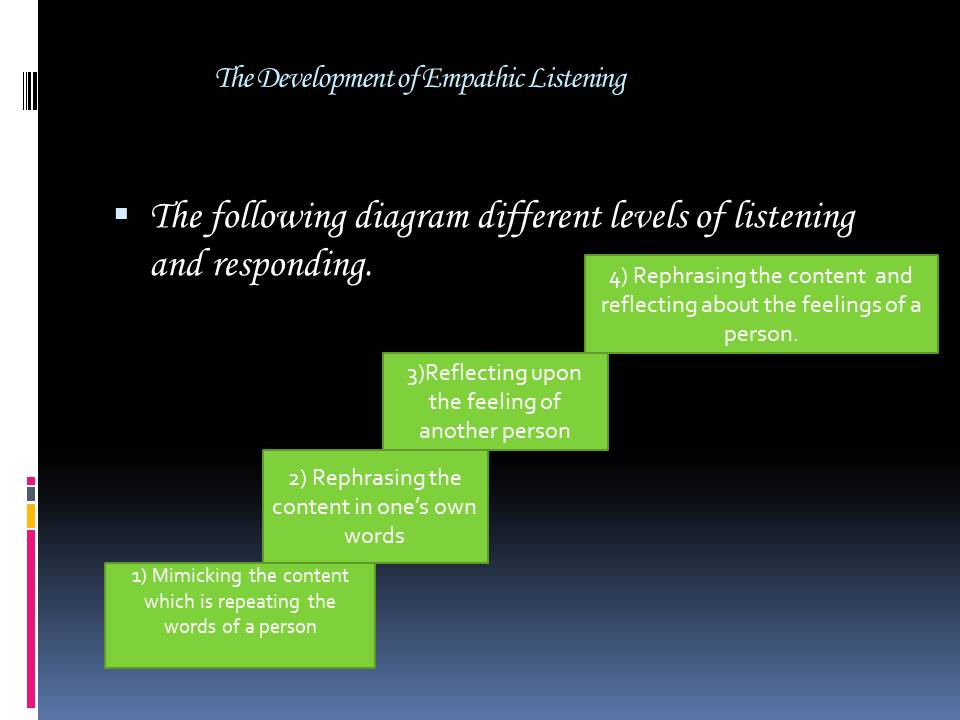
Empathic Listening: An Exercise for the Audience
Suppose that you are a parent of a student who currently attends a law school. After the first term in college, your son comes to you and says, “Dad/Mom, I don’t really want to be lawyer, I’d like to try something else”.
Please, think about your reaction to this situation and do the following:
- Rephrase the sentence in your own words;
- Reflect upon the intentions and feelings of this person and respond to his request in your words without mimicking the words of your interlocutor.
This exercise imitates a situation when a person has to listen empathically. In order to respond properly, one should first try to take into account the feelings and thoughts of another individual. By practicing such responses, one can better act in those situations when it is necessary to listen and respond empatically.

Autobiographical Responses: The Mistakes That People Should Avoid When Communicating
- Probing or asking questions without trying to take into account the needs and opinions of another person.
- Giving counsel which is based only on one’s own experiences.
- Interpreting people’s behavior and motives on the basis of our own views, values, and moral principles.
- Evaluation of a person’s behavior or intention that does not take into account his or her needs, attitudes, and values.
Autobiographical responses are the common communication errors that people make. They can be explained by the belief of many people that their way of thinking has to be shared by everyone else. As a rule, autobiographical responses make any interaction more difficult.
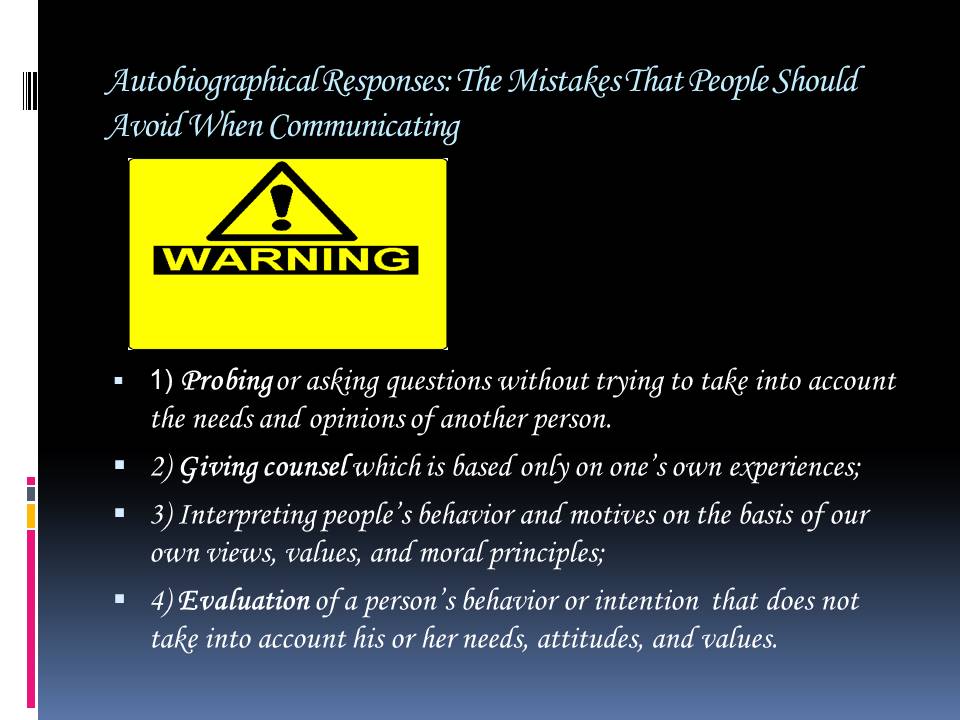
Examples of Autobiographical Responses
These phrases indicate that a listener did not really try to be empathetic. These are the examples of autobiographical responses;
- “I would have never done such a thing if I were you” – evaluation.
- “My experience tells me that you should do a certain thing” – advice.
- “You don’t know what you are saying”- interpretation.
- “I have been working here for many years. How can you tell me how to do my job?” – probing.
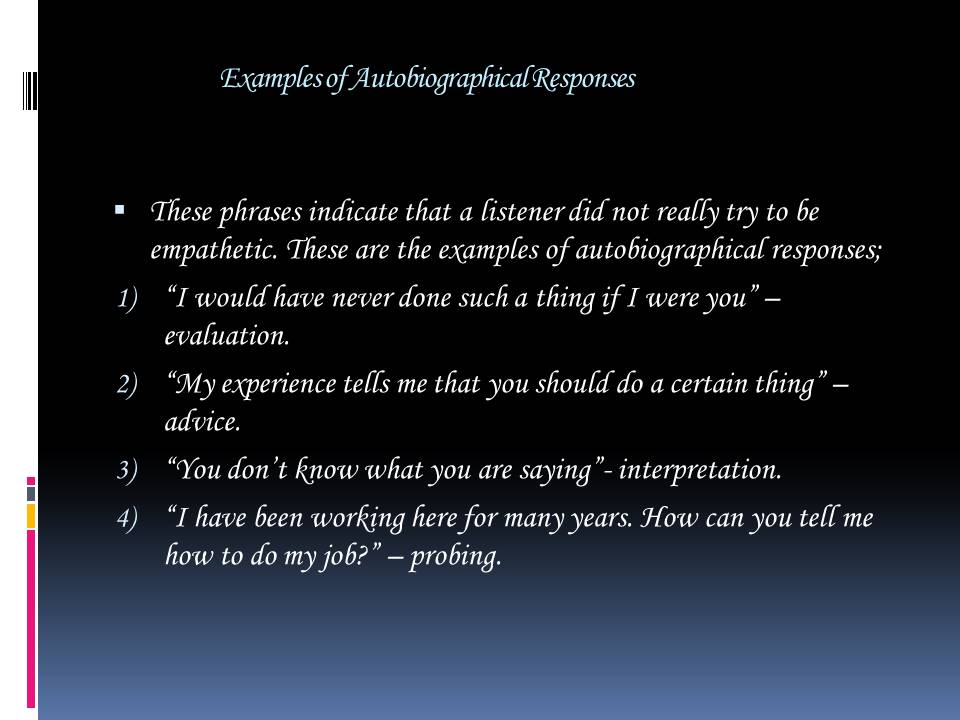
Why Autobiographic Responses Should Be Avoided
- They indicate you do not try to understand the feelings and needs of another person.
- Such responses suggest that you wish to impose your own views on another individual;
- They provoke a negative reaction to your words and ideas.
- They do not allow people to reach win-win solutions.
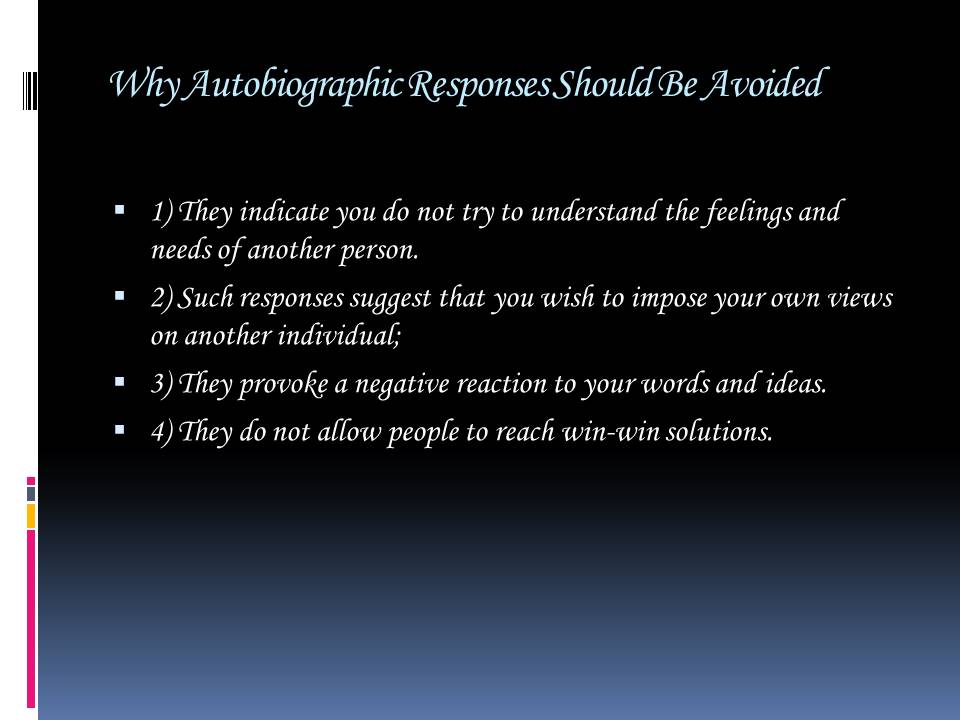
Identifying and Avoiding Autobiographical Responses: Practice for the Audience
Consider the following mini-dialogues. In case, identify the type of an autobiographical response and change it to an empathic response.
- Speaker 1: Dad, I don’t think that I will succeed in the law school.
- Speaker 2: Look, maybe you are not trying really hard.
- Speaker 1 Maybe, we should try a different approach to the design of this engine. It can be more effective.
- Speaker 2. It is not going to work.
- Speaker 1. I think that it’s a dead-end job, I really wish to look for something else.
- Speaker 2. I would not do that if I were you.
- Speaker 1. I’ve had a bad day at work and even received a reprimand from my boss.
- Speaker 2. Did you do something wrong?
In each case, Speaker 2 gives an autobiographical response and pays no attention to the views of Speaker 1. This exercise is helpful because it shows the pitfalls that a skillful communicator should avoid. Moreover, it prompts the audience to responds the sentences of Speaker 1 in an emphatic way.
These are the answers to the questions:
- Dialogue 1- interpretation;
- Dialogue 2 – evaluation;
- Dialogue 3- advice;
- Dialogue 4 – probing.
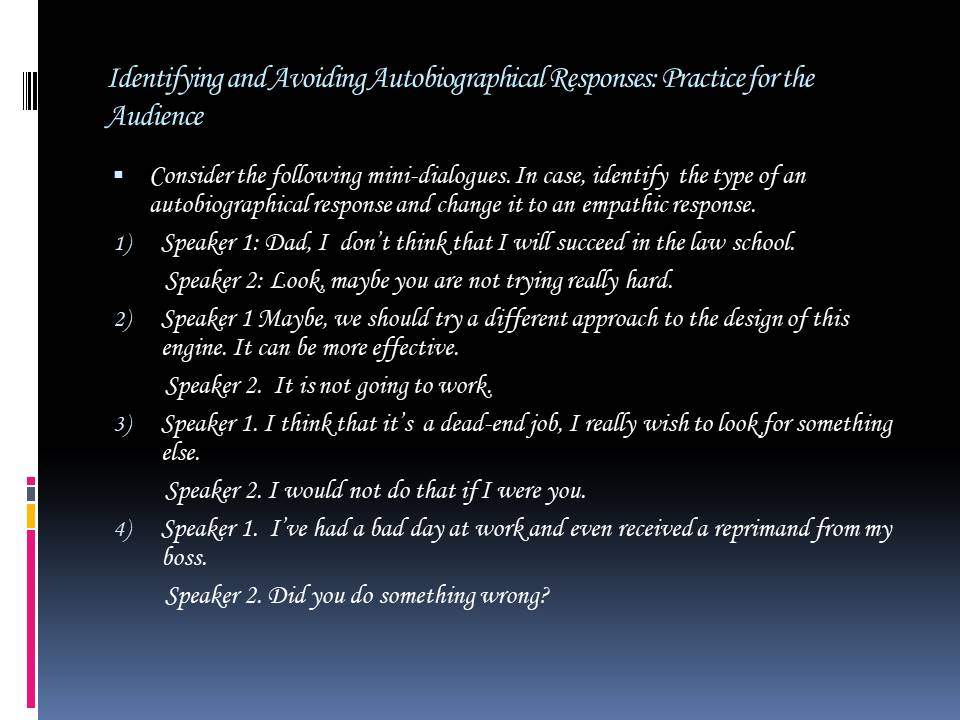
Perception of Things: Key Issues to Bear In Mind
The following diagram shows some of the factors that can influence people’s views of the same situation.
Perception:
- Age
- Income level
- Education
- Marital Status
- Gender
While talking to an individual, one should bear in mind that the assumptions, beliefs, and values of an individual can be influenced by his or her education, gender or age. If we do not take these factors into consideration, we may have significant disagreements and conflicts.
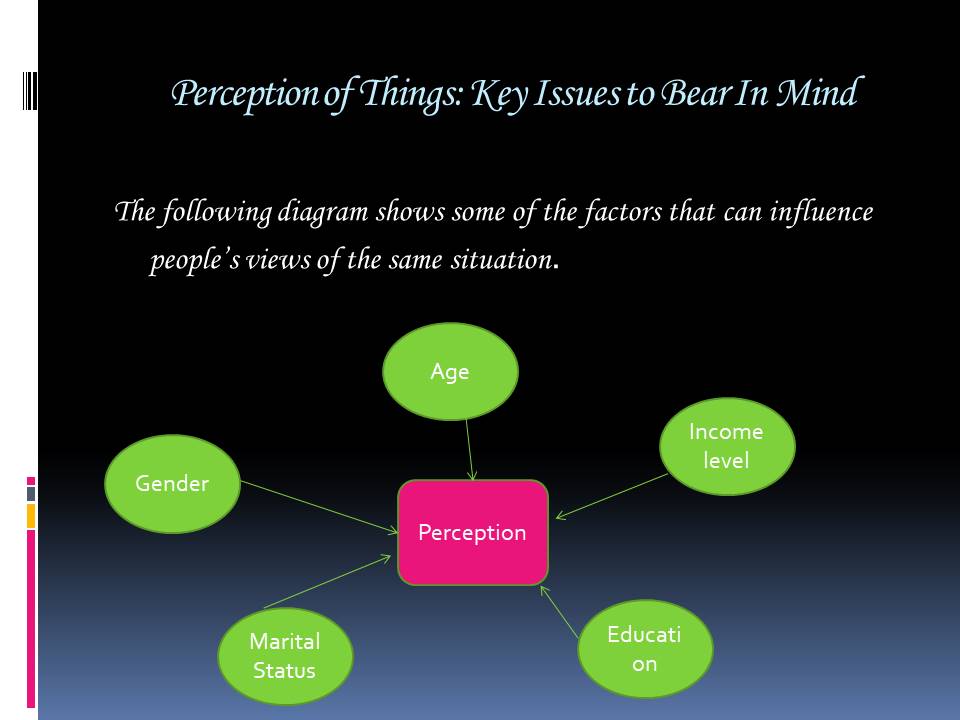
Understanding the Differences in Perceptions: A Prompt for the Audience
Suppose that you have accidentally overheard a part of a conversation. One of the interlocutors said , “ I don’t like the idea of having in the near future. They will only be an extra burden”.
Think of how different individuals may react to this phrase. Will these people give the sane assessment of this argument:
- An upwardly mobile and single bachelor.
- A married woman who already has children.
- An old male person who has both children and grandchildren.
- An female teenager who does not have children and who currently attends a college.
This exercise prompts the audience to think about the difference in people’s beliefs and perceptions. The individuals described here may either agree or disagree with the statement of an unknown interlocutor. By thinking about the perceptions of these characters, students will see that the same situation can be assessed in different ways. This awareness is important for reaching mutual understanding.
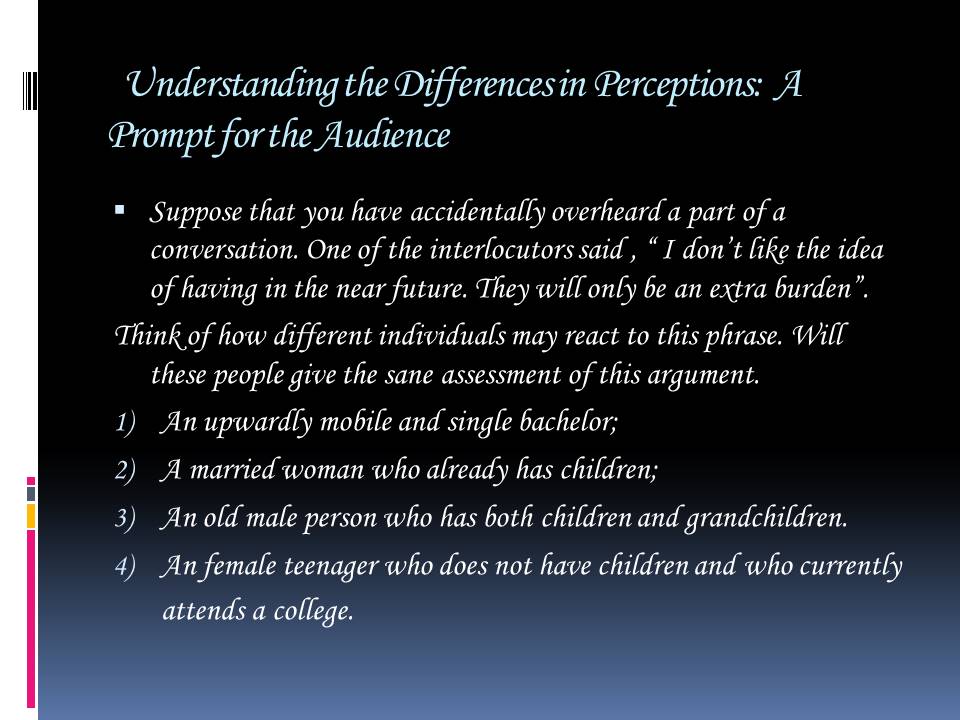
Making One’s Message Clear: How to Be Understood
According to Stephen Covey, an individual who wishes to appeal to the audience, should remember the following things:
- Ethos or the Ability to Prove One’s Competence or Integrity.
- Pathos or an appeal to emotions and feelings of an individual.
- Logos or an appeal to the logic and reasons of the audience.
According to Stephen Covey, a person should be able to use these types of appeal in order to communicate effectively. By combining them skillfully, he or she will make one’s ideas clear and produce a favorable impression on the audience.
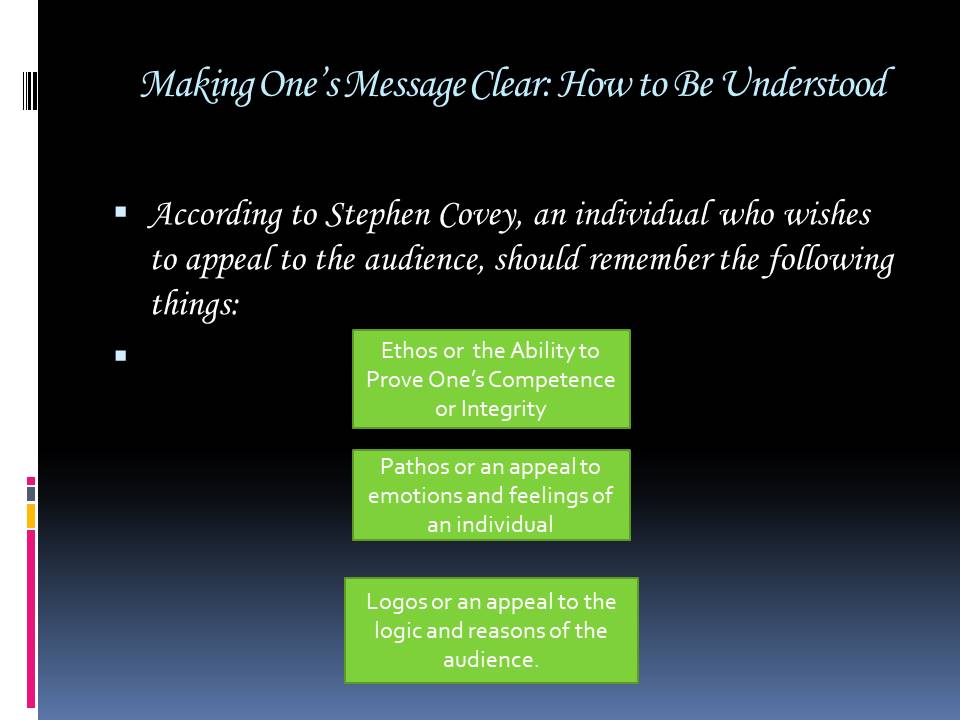
Identifying Pathos, Ethos, and Logos
Please, look at the following three statements and identify which one of them is pathos, ethos, or logos.
- I am aware of the hardships that you’ve encountered and I will do my best to help you.
- As a medical professional, I will do everything to meet the needs of my patients.
- You will benefit if you follow my advice. It is in your best interest.
These are the answers to the exercises:
- Statement 1 – pathos;
- Statement 2 – ethos;
- Statement 3 – logos.
These exercise is important because it shows how different types of appeals can be used and what kind of impression that can produce on the listeners.

The Need to Understand and to Be Understood: How They Can Be Reconciled
This diagram shows how people can find an equilibrium between their need to understand and to be understood.
Strategies for Convincing the Audience:
- Empathetic Listening:
- Making an Appeal to the Emotions of the Audience.
- Understanding perceptions and beliefs of a person:
- Appealing to the logic of another person.
This diagram is important because it illustrates how a person can convert empathetic listening skills in order to better communicate and convince the audience.
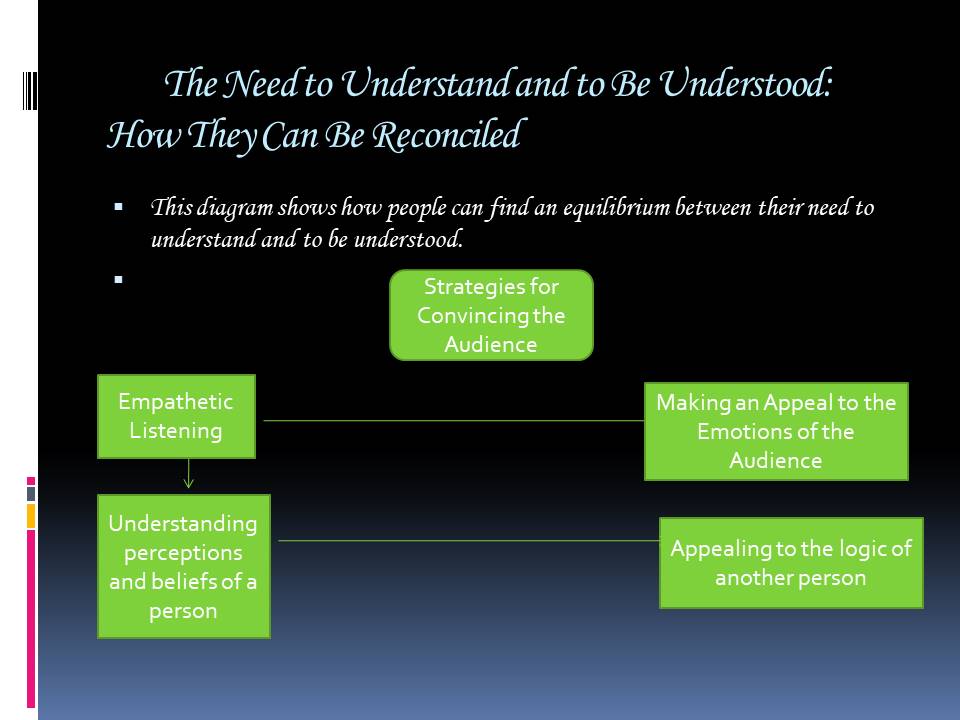
Follow-up Advice
This discussion that a person, who wishes to understand and to be understood, should do the following things:
- Look at the situation from different standpoints.
- Be careful when giving autobiographical responses that are based only on one’s experiences.
- Listen and respond empathically.
- Remember about the differences in perceptions.
- Skillfully combine ethos, pathos, and logos.
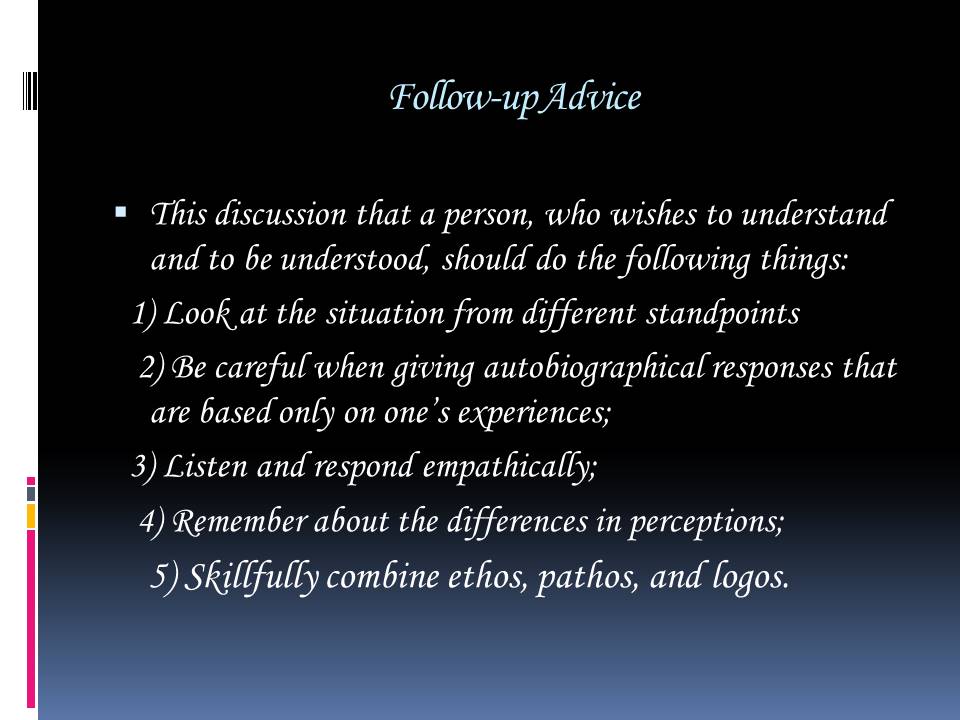
Conclusion
Thus, the habit described by Stephen Covey can be viewed as a set of the following components:
- Careful “diagnosis”;
- Empathetic listening;
- Avoiding autobiographical responses;
- Understanding perceptual differences and ability to produce a favorable impression on the audience.
